Alchemy
In Arabic, the land of Egypt is referred to as Al Khem. The name provides the root of our modern word “alchemy,” and offers a fresh insight not just into the ancient land of Khemet, but also the purpose of its most important temples.

Above: a priestess indicates the divine ratios of her forearms
Alchemy, of course, was the mythical art of transmuting base metals into gold. But in the esoteric tradition this process was meant to be seen as a metaphor. Consequently, the ultimate pursuit of the alchemist’s art was the transformation of the initiate herself. In this spiritual awakening, the adept balances syntropy with entropy.
Transmuting the pupil was the aim of the Egyptian mystery schools. Their classrooms were the temples: from Philae in the south to Heliopolis in the north. Indeed, their sanctums once hosted famous initiates like Pythagoras and Plato. Attendees would often spend years at a specific location being taught one aspect of the sacred sciences before graduating on to more advanced temples.

Above: a detail of a rod displayed in the Museo Egizo in Turin
Royal Cubit rods were utilitarian and ceremonial. Some models from private tombs show that they could also be received as honorary awards—a distinguishing offering to a deserving architect. Indeed, upon this rod to Any was written:
A boon that the king gives to Atum-Ra and to Ptah, lord of the two lands, and to Thoth, lord of divine words, great god who dwells in Hermopolis, that they may give life, prosperity and health and a good lifespan, following their ka’s, for the ka of the servant in the place of truth.
Thoth was sometimes referred to as Lord of the Cubit. As the god of writing, arts and geometry he inspired the scribes and those who made measurements. Indeed, everything suggests that this instrument was an essential tool for the craftsmen and technicians who were involved in all kinds of architectural work. Symbolically, this standard ruler ensures the control of time and space. Essential to the deeper truths, the Royal Cubit was protected within the temple of Hermopolis:
 The standard length of a rod was 52.37 centimetres. If we take this measure as a harmonic partial of the Sun using the ancient method described here then we find the circumference of the solar disc to be nearly 4.4 million kilometres. You may also recall that the Great Pyramid was built using solar and lunar ratios. After all, in galactic terms, is the Sun a particle or a wave—or both?
The standard length of a rod was 52.37 centimetres. If we take this measure as a harmonic partial of the Sun using the ancient method described here then we find the circumference of the solar disc to be nearly 4.4 million kilometres. You may also recall that the Great Pyramid was built using solar and lunar ratios. After all, in galactic terms, is the Sun a particle or a wave—or both?

The graphic above is written in base 11 which nicely reflects the Egyptian use of prime number ratios as a function of consciousness. It also implies a direct relationship between the base length of the Great Pyramid and the Earth’s diameter. (If we convert 440 Royal Cubits to the metric system we get 0.23 kilometres.) Dividing the Earth’s diameter by 0.23 kilometres we get 55,400—a small but significant harmonic.

Below is an aerial photo of the Great Pyramid at Giza. The square formed at the base (440 Royal Cubits per side) is twice the area of the nested square formed at the King’s Chamber level (above). Pyramids then, are really just 3D nested squares. But what does this pattern hint at and why did the pyramid need to be EXACTLY this size?

Well, we explored this diagram here as a way of DRAWING consciousness. But what it you wanted to BUILD consciousness?

In other words, if a cube and a star tetrahedron share the same edges, then it’s no surprise that this wavelength of √2 can be reflected in two dimensions as well. This mathematical sleight-of-hand reveals the very genesis of life on this planet. Indeed, we can draw a star tetrahedron touching Earth’s sphere. In geometric terms, this gives the circle and star a circumference-to-side ratio of π : √3.

Next we can take the star tetrahedron’s side length of 22,000 kilometres and convert it to an XY projection:

By nesting it 33 times within itself (a simplified version is below) we arrive at 0.23 kilometres or the base length of the Great Pyramid:

33 is a number of great significance. It represents the pathway to peace or the lotus flower between human awareness and cosmic consciousness. The spiral created by nested squares then, is really the inward stairway to heaven. Geometrically, it represents the rhombic dodecahedron (enlightenment).
Indeed, thousands of years ago the great architects realised the sacred ratios of consciousness also appeared in rose granite. The purpose of the pyramid then, was to create enlightened beings capable of uniting the cosmos within themselves. These philosophers were able to maintain a perfect balance within their own consciousness and create a sonic temple based on the dimensions of life itself.

So the Eye of Providence can refer to the part of the pyramid that is above ground—the rest makes up a crystal within the bedrock. Since time immemorial this stargate has offered an invitation to those who would balance the anima with the anima mundi.
